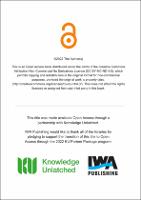Jar Tests for Water Treatment Optimization
How to Perform Jar Tests – a handbook
| dc.contributor.author | Pivokonský, Martin | |
| dc.contributor.author | Novotná, Kateřina | |
| dc.contributor.author | Čermáková, Lenka | |
| dc.contributor.author | Petříček, Radim | |
| dc.date.accessioned | 2022-08-18T05:36:12Z | |
| dc.date.available | 2022-08-18T05:36:12Z | |
| dc.date.issued | 2022 | |
| dc.identifier.uri | https://library.oapen.org/handle/20.500.12657/57997 | |
| dc.description.abstract | The book is intended as a handbook providing detailed instructions for the correct conducting of jar tests, which are needed for the optimisation of the coagulation/flocculation process. It contains the essential theoretical background of coagulation/flocculation, including a description of the influence of different parameters on the coagulation efficiency of various impurities (e.g. pH value and type/dose of coagulant), and floc properties and their separation (e.g. mixing intensity, mixing time, but also type/concentration of coagulant and impurities). The principle of jar tests is explained and parameters possible to optimize (i.e. coagulation pH, coagulant dose, flocculation aid dose, mixing intensity and mixing time) are discussed. Laboratory equipment for jar tests is proposed, including mixers and instructions for calculating a mixing intensity (necessarily expressed by the global shear rate/velocity gradient G). Mixing intensities for various purposes are recommended. Detailed practical instructions of how to perform jar tests follow, including a determination of the dose of reagents for pH adjustment and coagulant dose, dosing sequence, floc separation after jar tests by sedimentation and/or centrifugation simulating sand filtration, sampling, measuring necessary parameters (pH, coagulant residuals, alkalinity, residual impurity concentrations etc.), data recording, data processing and jar test evaluation (with specific examples). The handbook also contains a supplementary part with tables for conversion of the molar to mass concentration (and vice versa) of coagulants, and instructions for diluting coagulants and reagents for pH adjustment. | |
| dc.language | English | |
| dc.subject.classification | thema EDItEUR::T Technology, Engineering, Agriculture, Industrial processes::TQ Environmental science, engineering and technology | en_US |
| dc.subject.classification | thema EDItEUR::P Mathematics and Science::PD Science: general issues::PDG Industrial applications of scientific research and technological innovation | en_US |
| dc.subject.classification | thema EDItEUR::T Technology, Engineering, Agriculture, Industrial processes::TT Other technologies and applied sciences::TTU Mining technology and engineering | en_US |
| dc.subject.other | Science | |
| dc.subject.other | Environmental Science | |
| dc.subject.other | Science | |
| dc.subject.other | Applied Sciences | |
| dc.subject.other | Technology & Engineering | |
| dc.subject.other | Mining | |
| dc.title | Jar Tests for Water Treatment Optimization | |
| dc.title.alternative | How to Perform Jar Tests – a handbook | |
| dc.type | book | |
| oapen.identifier.doi | https://doi.org/10.2166/9781789062694 | |
| oapen.relation.isPublishedBy | dc3cfe72-8424-48e6-b8e0-fca2844ba38e | |
| oapen.relation.isFundedBy | b818ba9d-2dd9-4fd7-a364-7f305aef7ee9 | |
| oapen.relation.isbn | 9781789062694 | |
| oapen.collection | Knowledge Unlatched (KU) | |
| oapen.imprint | IWA Publishing | |
| oapen.identifier | https://openresearchlibrary.org/viewer/627d43bf-1246-4796-b1d9-2d5410c8cdf1 | |
| oapen.identifier.isbn | 9781789062694 |

